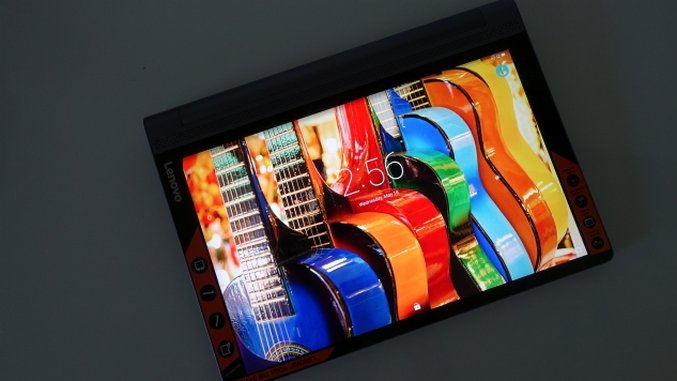
Lenovo’s pro designation of the Yoga Tab 3 Pro is slightly misleading. The company’s flagship Android tablet packs as much fun as it does productivity, and the slate comes with innovative features baked in, like a splash-proof nano-coating making it suitable for use in the kitchen, support for gesture controls and a built-in pico projector. Consumers looking for an even bigger screen will find a lot to love, as you can now project your favorite photos, videos and Netflix experience to a wall up to 70 inches.
Unlike its competitors, Lenovo opted not to go with a flat slate design for its Yoga series of consumer tablets. The Yoga Tab 3 Pro boasts an impressively slim frame, making it competitive with Apple’s iPad Air line and Samsung’s Galaxy Tab S series, but the star of Lenovo’s show is a cylindrical barrel on the bottom spine. This barrel design houses the projector, a flip-out kickstand, impressive 11.5-hour battery life during my testing and four loud, crisp speakers tuned by JBL.
The barrel design also means that you’ll have an ergonomic grip when the Yoga Tab 3 Pro is held in portrait orientation. When reading e-books and documents, I found the barrel design to closely mimic a magazine that’s been folded back onto itself, making the Yoga Tab 3 Pro much more comfortable to hold than the iPad for long reading sessions. It’s a design that Amazon is mirroring on the company’s premium Kindle Oasis e-reader.
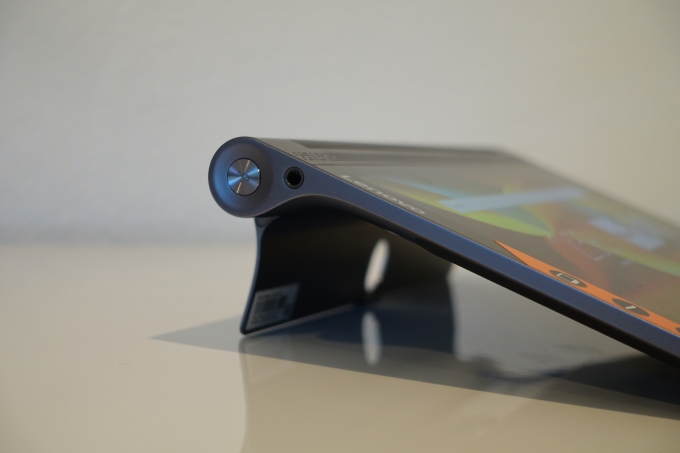 To engage the kickstand, you have to push a button on the back of the tablet. Like Microsoft’s Surface Pro 4, the kickstand allows the Yoga to be used at various angles of tilt, and if you’re working in the kitchen and want to follow a recipe to cook your favorite dish, you can even hang the Yoga Tab 3 to a hook through a small hole in the center of the kickstand. When working, I prefer to just prop out the kickstand so that the screen is slightly angled on my desk or lap. This makes it easy to respond to emails and read messages.
To engage the kickstand, you have to push a button on the back of the tablet. Like Microsoft’s Surface Pro 4, the kickstand allows the Yoga to be used at various angles of tilt, and if you’re working in the kitchen and want to follow a recipe to cook your favorite dish, you can even hang the Yoga Tab 3 to a hook through a small hole in the center of the kickstand. When working, I prefer to just prop out the kickstand so that the screen is slightly angled on my desk or lap. This makes it easy to respond to emails and read messages.
Even though the barrel adds functionality to the Yoga Tab 3 Pro, it’s a divisive design choice. In portrait mode when placed on the flat surface of the desk, design purists will scoff at the asymmetrical design. Given that the barrel is found on one edge, this means that the Yoga will slope to one side instead of laying perfectly flat on your desk. In landscape orientation, this slope is less jarring.
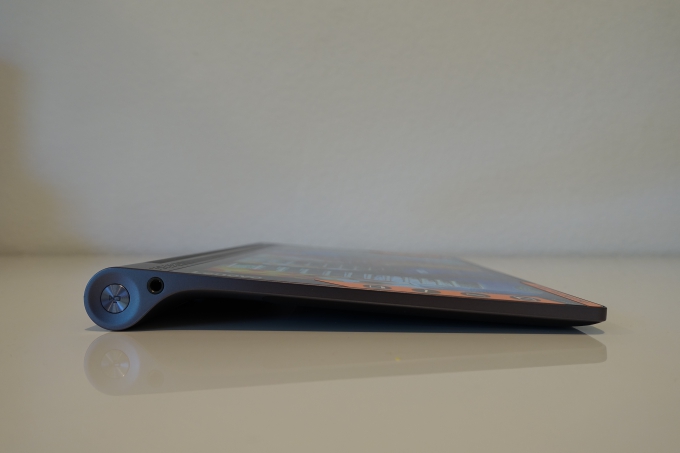 Unlike the all-aluminum iPad, however, Lenovo’s use of metal is more reserved. On the Yoga Tab 3 Pro, metal is used along the spines, barrel and kickstand to give the slate its structural integrity, and Lenovo opted to use a faux, but realistic feeling, leather material on the rear. It was a design inspiration taken from the Moto X series following Lenovo’s acquisition of Motorola, and the effect on the tablet is no less nice.
Unlike the all-aluminum iPad, however, Lenovo’s use of metal is more reserved. On the Yoga Tab 3 Pro, metal is used along the spines, barrel and kickstand to give the slate its structural integrity, and Lenovo opted to use a faux, but realistic feeling, leather material on the rear. It was a design inspiration taken from the Moto X series following Lenovo’s acquisition of Motorola, and the effect on the tablet is no less nice.
The leather and metal design gives the Yoga a modern appeal, while being functional at the same time. The choice of materials aids in the gripability of the tablet. Not only does the faux leather back feel nice and look premium, but it also makes the tablet inviting to pick up, as it doesn’t feel as cold as the iPad.
After several years of experimenting with the kickstand design on the Yoga Tab series, the design really comes together on the Yoga Tab 3 Pro. With the kickstand engaged, the projector turned on and playing your favorite flick with audio piped out the quad-JBL speakers, the Yoga Tab 3 Pro is a mobile entertainment powerhouse.
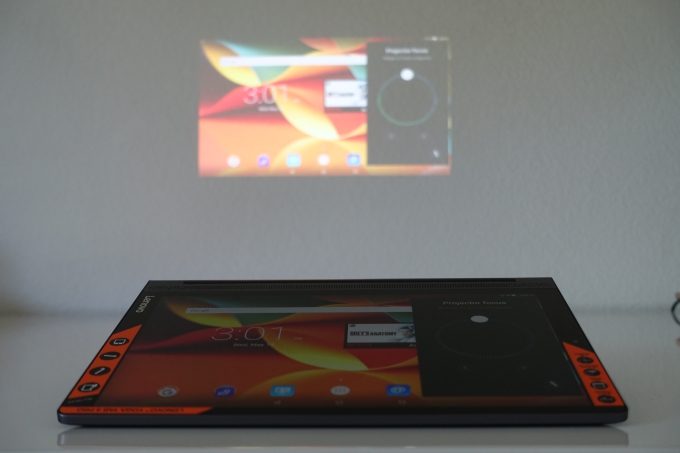 The kickstand makes it easy to prop up the tablet to a good height to begin projecting. The projector can be activated with a dedicated button on the right edge of the barrel or through the software controls. There is even keystone correction with the projector, which helps gives you as straight an image as possible even if the projector is skewed and not perfectly level. Lenovo’s software allows you to adjust the focus so you get a sharp picture.
The kickstand makes it easy to prop up the tablet to a good height to begin projecting. The projector can be activated with a dedicated button on the right edge of the barrel or through the software controls. There is even keystone correction with the projector, which helps gives you as straight an image as possible even if the projector is skewed and not perfectly level. Lenovo’s software allows you to adjust the focus so you get a sharp picture.
Even though Lenovo makes ambitious claims with a 70-inch screen size with the projector, the results were more modest. You’re getting a 480p — VGA resolution — display and not a 1080p from most high-end home projector systems, and you’re also getting a more battery-friendly 50-lumen projector bulb. Even ZTE’s Spro 2 comes with a brighter bulb at 200 lumens, and most home projectors come with a bulb brightness between 1,000 and 2,000 lumens. This means that in anything but a pitch black room, your projected image will be washed out and hard to see.
Despite the projector’s specifications, the result is no less impressive considering the compact package. Excluding the slightly bulbous barrel, the Yoga Tab 3 Pro measures just 0.18 inches thick, making it half as thick as Apple’s iPad AIr 4, which comes in at 0.37 inches. I found the projector to be more than a novelty. Given that I don’t have a television in my bedroom, the projector did a good job of letting me stream some of my favorite television shows at night. And even though you can get up to a 70-inch image projected, I found that the smaller the projected area, the brighter the image.
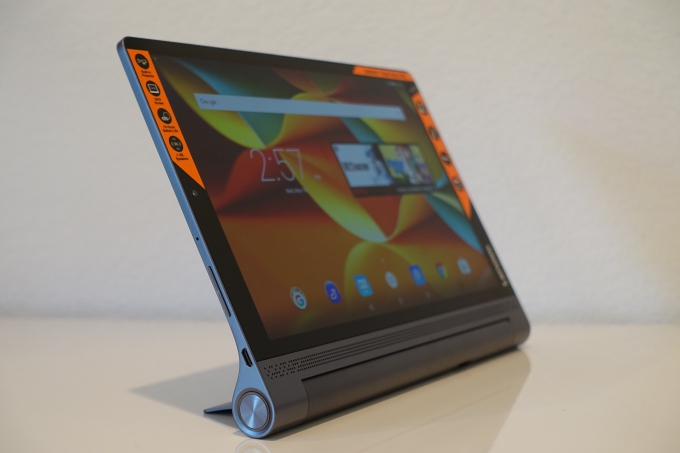 If you decide to not use the projector, you can still view content on the 10.1-inch QHD screen on the Yoga Tab 3 Pro. The display’s resolution of 1,600 × 2,560 is crisp, giving the screen a resolution of 299 pixels per inch (ppi). The Yoga Tab 3 Pro looks as bright as an iPad, and colors appear very accurate with deep blacks.
If you decide to not use the projector, you can still view content on the 10.1-inch QHD screen on the Yoga Tab 3 Pro. The display’s resolution of 1,600 × 2,560 is crisp, giving the screen a resolution of 299 pixels per inch (ppi). The Yoga Tab 3 Pro looks as bright as an iPad, and colors appear very accurate with deep blacks.
The quad-speaker array gives the Yoga Tab 3 Pro a mini-soundbar experience. Lenovo worked with Dolby to bring the audio house’s Atmos technology to give you an immersive sound experience. In use, you won’t find the same left- and right-channel stereo isolation that you would at an Atmos-powered theater considering how small the Yoga Tab 3 Pro is and and how closely spaced the speakers are. However, there are some presets to tune the tablet to better suit your content, whether you’re listening to vocals in a song, tuning the speakers for movie mode or boosting the sound effects in games.
As a premium tablet, the Yoga Tab 3 Pro performed swiftly, handling everyday tasks with ease. Games played without hiccup, and I didn’t experience any lags even when multitasking on the tablet, juggling between Google Docs, Gmail, Chrome and Pandora.
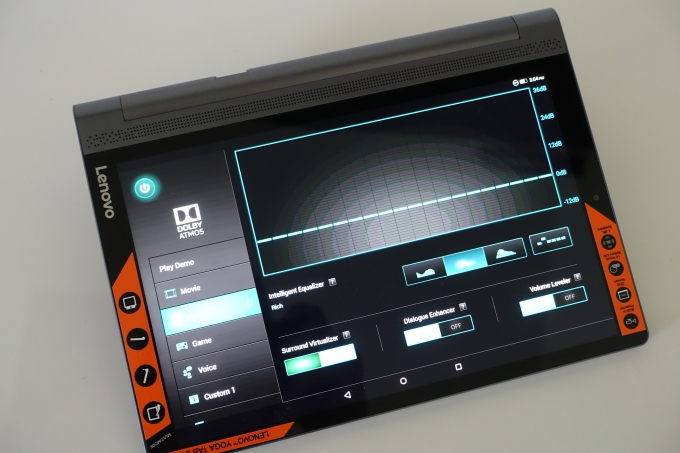 Powering the tablet is a quad-core 64-bit Intel Atom x5 processor, a shift away from the ARM-based architecture found on many Android slates, along with 2GB RAM. The Yoga comes with integrated Intel HD graphics. There is 32GB of flash storage on the device to store your apps and content, but you’ll want to invest in a microSD card if you want to load up on videos, photos, music and movies to use with the integrated pico projector.
Powering the tablet is a quad-core 64-bit Intel Atom x5 processor, a shift away from the ARM-based architecture found on many Android slates, along with 2GB RAM. The Yoga comes with integrated Intel HD graphics. There is 32GB of flash storage on the device to store your apps and content, but you’ll want to invest in a microSD card if you want to load up on videos, photos, music and movies to use with the integrated pico projector.
Like its Motorola phone subsidiary, Lenovo didn’t make many tweaks to the Yoga’s near-stock edition of Google’s Android 5.1 Lollipop operating system. There are a few pre-loaded apps, including Netflix and McAfee Security, and Lenovo also added some of its own tweaks to “enhance” your experience.
One of these is a multi-window mode, which allows you to run several apps simultaneously. Lenovo also includes some of its own software experiences, including voice control that activates some limited hardware features of the tablet, and you can still use Google Now for everything else.
The tablet comes with a 13-megapixel rear camera and a front-facing 5-megapixel camera. Both cameras are capable of taking good, sharp images that preserved a fair amount of details. Even if you don’t like using a tablet to snap photos, you can still benefit from the cameras. With support for gesture controls, you can flick your hand, for instance, to jump through a photo slideshow.
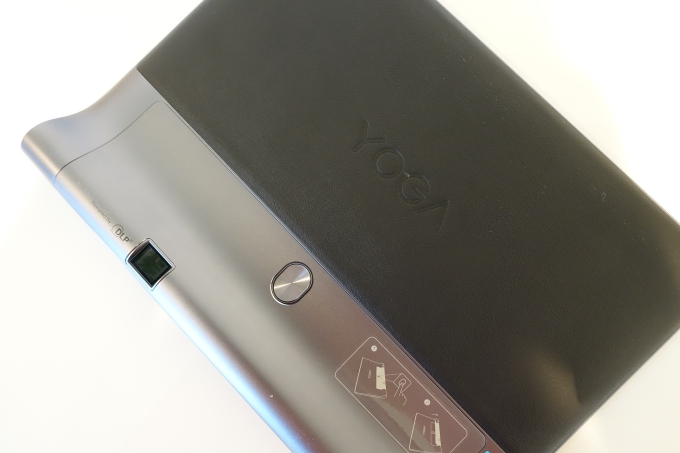 At $499, the Yoga Tab 3 Pro competes against some of the best tablets on the market. Even compared against tablets with digital inking capabilities and active stylus input, like Microsoft’s Surface Pro 4 and Apple’s iPad Pro, the Yoga Tab 3 Pro can hold its own ground. Even though the Yoga doesn’t come with support for a stylus or active digitizer, Lenovo has built in its AnyPen technology, allowing you to use most metal objects as a make-shift stylus. This means that in addition to your blunt fingers, you can use a pen, your car keys or even a razor blade to sketch or doodle on the Yoga’s screen.
At $499, the Yoga Tab 3 Pro competes against some of the best tablets on the market. Even compared against tablets with digital inking capabilities and active stylus input, like Microsoft’s Surface Pro 4 and Apple’s iPad Pro, the Yoga Tab 3 Pro can hold its own ground. Even though the Yoga doesn’t come with support for a stylus or active digitizer, Lenovo has built in its AnyPen technology, allowing you to use most metal objects as a make-shift stylus. This means that in addition to your blunt fingers, you can use a pen, your car keys or even a razor blade to sketch or doodle on the Yoga’s screen.
Last year, when I met with the company, Lenovo demoed a carrot as a stylus for the Yoga, which gives the tablet even more flexibility. Compared to the iPad Pro, for example, if you forget the Apple Pencil at home, you’re out of luck. With the Yoga, you can just use any old graphite pencil and you’re off to sketching. The downside with the Yoga is that if you use a sharp object, you risk scratching or damaging the screen over time. I also wasn’t able to test how well AnyPen works when there’s a plastic or glass screen protector on the display.
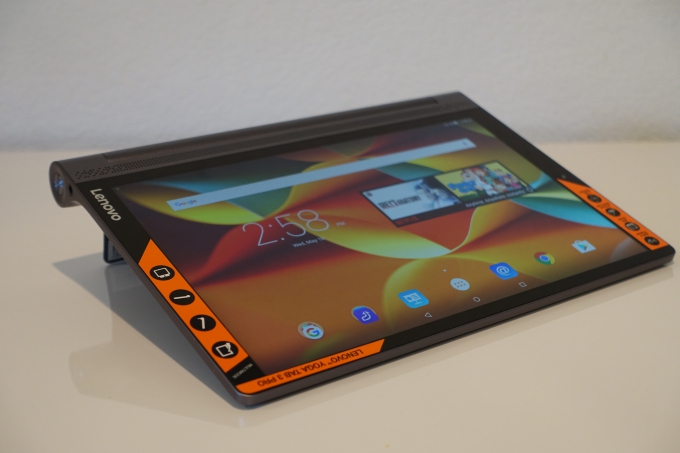 As a slate, the Yoga brings a more complete feature-set to consumers, including some of the best speakers on a tablet and an integrated pico projector. I appreciated the built-in kickstand, and as a reader of digital magazines and e-books, I loved the controversial barrel spine design for its ergonomic comfort.
As a slate, the Yoga brings a more complete feature-set to consumers, including some of the best speakers on a tablet and an integrated pico projector. I appreciated the built-in kickstand, and as a reader of digital magazines and e-books, I loved the controversial barrel spine design for its ergonomic comfort.
Even if you don’t intend on using the projector heavily, the integrated kickstand makes it easy to prop up the screen to any angle without the need for a case. The tablet’s long battery life makes it a good companion for travel, as well. In the Yoga Tab 3 Pro, Lenovo has put forth its vision of Android in a tablet with features that are unmatched by any competitor.
About Unknown
0 comments:
Post a Comment